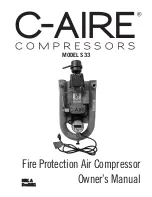
A
PPLICATION
GUIDELINES
I
NSTALLATION
Refrigerant charging
It is recommended that system charging be done
using the weighed charge method, adding refrig-
erant to the high side of the system. Charging the
high and low sides of a system with gas simulta-
neously at a controlled rate is also an acceptable
method. Do not exceed the recommended unit
charge, and never charge liquid to the low side.
Vacuum or charge from one side can seal the
scrolls and result in a non-starting compressor.
When servicing, always ensure that LP/HP pres-
sures are balanced before starting the compres-
sor.
Be sure to follow all government regulations re-
garding refrigerant reclamation and storage.
Liquid line fi lter driers
A properly sized & type of drier is required. Im-
portant selection criteria include the driers water
content capacity, the system refrigeration capac-
ity, and the system refrigerant charge. The drier
must be able to reach and maintain a moisture
level of 50 ppm end point dryness (EPD). Danfoss
recommends DCL (solid core) driers for the MLM
compressor (R22 with Alkylbenzene) and DML
(100% molecular sieve) driers for MLZ compres-
sors (R404A, R507, R134a, R22) with PVE oil.
For servicing of existing installations where acid
formation may be present, the Danfoss DCL solid
core filter drier containing activated alumina is
recommended.
After burn out, remove & replace the liquid line
filter drier and install a Danfoss type DAS burnout
drier of the appropriate capacity. Refer to the DAS
drier instructions and technical information for
correct use of the burnout drier on the liquid line.
Insulation resistance and
dielectric strength
Insulation resistance must be higher than 1 mego-
hm when measured with a 500 volt direct current
megohm tester.
Each compressor motor is tested at the factory
with a high potential voltage (hi-pot) that exceeds
the UL requirement both in potential and in dura-
tion. Leakage current is less than 0.5 mA.
MLZ/MLM scroll compressors are configured with
the pump assembly at the top of the shell, and the
motor below. As a result, the motor can be partial-
ly immersed in refrigerant and oil. The presence of
refrigerant around the motor windings will result
in lower resistance values to ground and higher
leakage current readings. Such readings do not
indicate a faulty compressor, and should not be
cause for concern.
In testing insulation resistance, Danfoss recom-
mends that the system be first operated briefly to
distribute refrigerant throughout the system. Fol-
lowing this brief operation, retest the compressor
for insulation resistance or current leakage.
Never reset a breaker or replace a fuse without
first checking for a ground fault (a short circuit to
ground). Be alert for sounds of arcing inside the
compressor.
35
FRCC.PC.016.A1.22






































